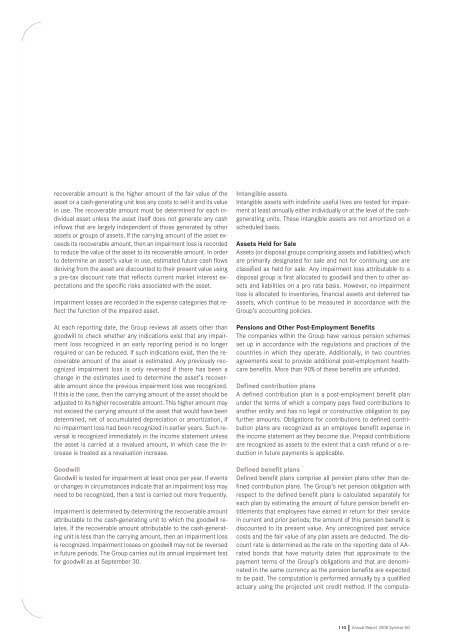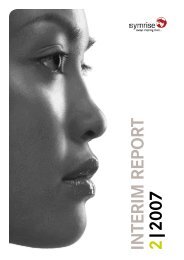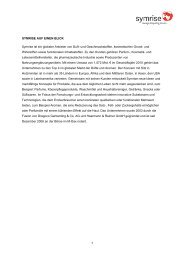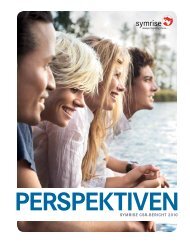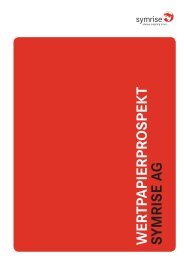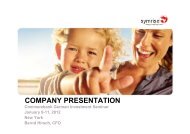THE NATURE OF OUR BUSINESS – STABLE GROWTH - Symrise
THE NATURE OF OUR BUSINESS – STABLE GROWTH - Symrise
THE NATURE OF OUR BUSINESS – STABLE GROWTH - Symrise
Create successful ePaper yourself
Turn your PDF publications into a flip-book with our unique Google optimized e-Paper software.
ecoverable amount is the higher amount of the fair value of the<br />
asset or a cash-generating unit less any costs to sell it and its value<br />
in use. The recoverable amount must be determined for each individual<br />
asset unless the asset itself does not generate any cash<br />
inflows that are largely independent of those generated by other<br />
assets or groups of assets. If the carrying amount of the asset exceeds<br />
its recoverable amount, then an impairment loss is recorded<br />
to reduce the value of the asset to its recoverable amount. In order<br />
to determine an asset’s value in use, estimated future cash flows<br />
deriving from the asset are discounted to their present value using<br />
a pre-tax discount rate that reflects current market interest expectations<br />
and the specific risks associated with the asset.<br />
Impairment losses are recorded in the expense categories that reflect<br />
the function of the impaired asset.<br />
At each reporting date, the Group reviews all assets other than<br />
goodwill to check whether any indications exist that any impairment<br />
loss recognized in an early reporting period is no longer<br />
required or can be reduced. If such indications exist, then the recoverable<br />
amount of the asset is estimated. Any previously recognized<br />
impairment loss is only reversed if there has been a<br />
change in the estimates used to determine the asset’s recoverable<br />
amount since the previous impairment loss was recognized.<br />
If this is the case, then the carrying amount of the asset should be<br />
adjusted to its higher recoverable amount. This higher amount may<br />
not exceed the carrying amount of the asset that would have been<br />
determined, net of accumulated depreciation or amortization, if<br />
no impairment loss had been recognized in earlier years. Such reversal<br />
is recognized immediately in the income statement unless<br />
the asset is carried at a revalued amount, in which case the increase<br />
is treated as a revaluation increase.<br />
Goodwill<br />
Goodwill is tested for impairment at least once per year. If events<br />
or changes in circumstances indicate that an impairment loss may<br />
need to be recognized, then a test is carried out more frequently.<br />
Impairment is determined by determining the recoverable amount<br />
attributable to the cash-generating unit to which the goodwill relates.<br />
If the recoverable amount attributable to the cash-generating<br />
unit is less than the carrying amount, then an impairment loss<br />
is recognized. Impairment losses on goodwill may not be reversed<br />
in future periods. The Group carries out its annual impairment test<br />
for goodwill as at September 30.<br />
Intangible assets<br />
Intangible assets with indefinite useful lives are tested for impairment<br />
at least annually either individually or at the level of the cashgenerating<br />
units. These intangible assets are not amortized on a<br />
scheduled basis.<br />
Assets Held for Sale<br />
Assets (or disposal groups comprising assets and liabilities) which<br />
are primarily designated for sale and not for continuing use are<br />
classified as held for sale. Any impairment loss attributable to a<br />
disposal group is first allocated to goodwill and then to other assets<br />
and liabilities on a pro rata basis. However, no impairment<br />
loss is allocated to inventories, financial assets and deferred tax<br />
assets, which continue to be measured in accordance with the<br />
Group’s accounting policies.<br />
Pensions and Other Post-Employment Benefits<br />
The companies within the Group have various pension schemes<br />
set up in accordance with the regulations and practices of the<br />
countries in which they operate. Additionally, in two countries<br />
agreements exist to provide additional post-employment healthcare<br />
benefits. More than 90% of these benefits are unfunded.<br />
Defined contribution plans<br />
A defined contribution plan is a post-employment benefit plan<br />
under the terms of which a company pays fixed contributions to<br />
another entity and has no legal or constructive obligation to pay<br />
further amounts. Obligations for contributions to defined contribution<br />
plans are recognized as an employee benefit expense in<br />
the income statement as they become due. Prepaid contributions<br />
are recognized as assets to the extent that a cash refund or a reduction<br />
in future payments is applicable.<br />
Defined benefit plans<br />
Defined benefit plans comprise all pension plans other than defined<br />
contribution plans. The Group’s net pension obligation with<br />
respect to the defined benefit plans is calculated separately for<br />
each plan by estimating the amount of future pension benefit entitlements<br />
that employees have earned in return for their service<br />
in current and prior periods; the amount of this pension benefit is<br />
discounted to its present value. Any unrecognized past service<br />
costs and the fair value of any plan assets are deducted. The discount<br />
rate is determined as the rate on the reporting date of AArated<br />
bonds that have maturity dates that approximate to the<br />
payment terms of the Group’s obligations and that are denominated<br />
in the same currency as the pension benefits are expected<br />
to be paid. The computation is performed annually by a qualified<br />
actuary using the projected unit credit method. If the computa-<br />
110 Annual Report 2008 <strong>Symrise</strong> AG


